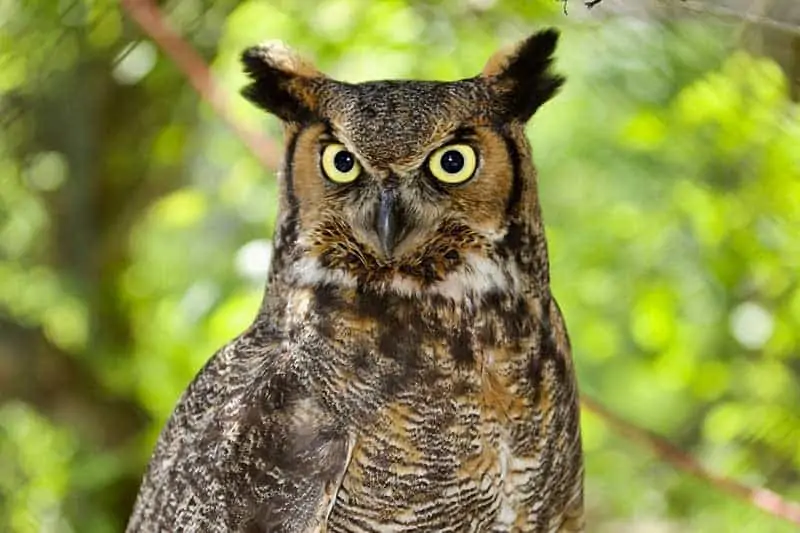I decided to write about the different kinds of owls in Arizona after writing an article about the numerous hawk species found in the state. Arizona has a mild environment that is ideal for hundreds of bird species, as well as several owls, to migrate through. While several owls live in Arizona all year, a few migrate from the south and aren’t permanent residents.
Based on multiple sources, including allaboutbirds.org and neotropical.birds.cornell.edu, I was able to confirm that these 13 species of owls in Arizona have a range. I’ll talk about the species in this article, describe where they may be found in Arizona, and share some interesting information.
OWLS IN ARIZONA
1. GREAT HORNED OWL

Length: 18.1-24.8 in
Weight: 32.1-88.2 oz
Wingspan: 39.8-57.1 in
The year-round residents of Arizona and all of North America are Great Horned Owls, which are huge birds of prey. They’re big-game hunters and vicious predators who typically devour other large birds of prey of comparable size. The enormous size, furrowed forehead, and ear tufts of Great Horned Owls, as well as their yellow eyes, are all easily recognized.
They may be found in woods, marshes, and deserts, as well as more urban environments such as cities, suburbs, and parks. They are quite common. The two raptors are known to be enemies, and Great Horned Owls are somewhat bigger than Red-tailed Hawks. They may be seen at dusk sitting on fence posts or in tree branches, waiting for darkness to come in. They are nocturnal but can often be found at dusk.
2. BARN OWL
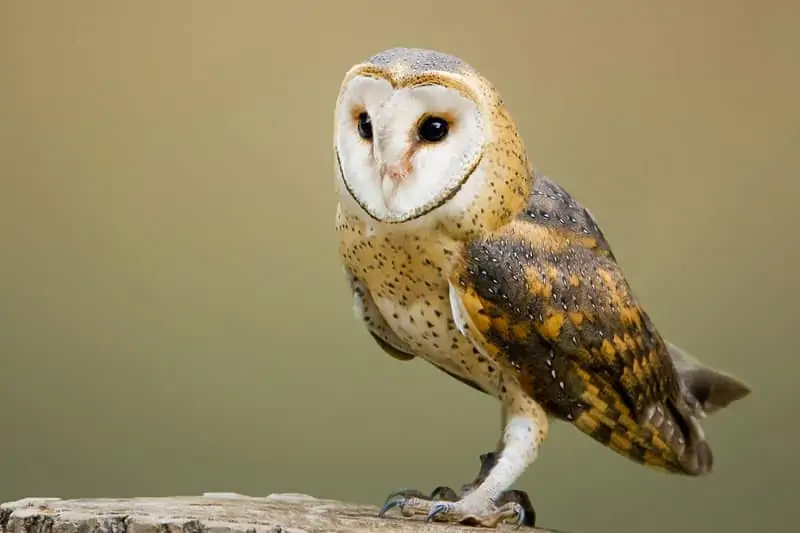
Length: 12.6-15.8 in
Weight: 14.1-24.7 oz
Wingspan: 39.4-49.2 in
Year-round residents of Arizona include Barn Owls. The whiteish, heart-shaped faces of these lovely birds of prey can help you identify them. By nesting in human-built constructions like dismantled buildings and barns, they earned their name. If you want to find one, look for flashes of light white wings or listen for their cries at night. They are notorious for being difficult to locate.
They’re nocturnal feeders that devour everything in their path, bones and all, and they’re quiet and efficient. The unneeded components are then regurgitated in pellet form. Like other owls, Barn Owls have superb low-light vision, but their capacity to detect and hunt prey based solely on sound is unparalleled to any other species of animal.
3. LONG-EARED OWL

Length: 13.8-15.8 in
Weight: 7.8-15.3 oz
Wingspan: 35.4-39.4 in
The majority of Arizona is home to Long-eared Owls all year. Unless you know which location and time to look for, these cryptic owls are extremely well disguised and difficult to detect. In place of the enraged one that the Great Horned Owl has, they have enormous ear tufts that give them a startled look.
For nesting, Long Eared Owls favor thick vegetation, while hunting, they favor open grasslands and fields. Little mammals, such as rats and juvenile rabbits, are the primary source of food for them, with other birds thrown in for good measure. If you want to locate one, listen for their long, low hoots at night, which may be heard from afar as well as owl pellets on the ground.
4. SHORT-EARED OWL

Length: 13.4-16.9 in
Weight: 7.3-16.8 oz
Wingspan: 33.5-40.5 in
The best chance to see a Short-eared Owl in Arizona is during the winter, since they have a non-breeding range. If you want to see one, look in open spaces such as meadows and fields at dawn or dusk. Each year, they go north to Canada and Alaska, where they breed.
These are one of the most common owls seen during the day, and they are found all over the globe. In the photo above, you may see their short ear tufts, but they are often flat and difficult to detect. The Short-eared Owl is a subspecies of the Pueo, Hawaii’s only native owl. Their overall population is believed to be in rapid decline, despite their wide distribution across the globe.
5. NORTHERN SAW-WHET OWL

Length: 7.1-8.3 in
Weight: 2.3-5.3 oz
Wingspan: 16.5-18.9 in
In most of Arizona, this little owl is year-round, but in the southwest corner of the state, it is non-breeding. The cat-like face, yellow eyes, and small size of the Northern Saw-whet Owl distinguish it. The name “saw-whet owl” refers to the fact that their whistles resemble a saw sharpened on a whetting stone.
On quiet evenings between January and May, listen for these elusive little owls in the woods. Their cry sounds like a “too too too,” which I’ve never heard. Like many other owls, they roost quietly in the trees and may be difficult to locate.
6. WESTERN SCREECH-OWL

Length: 7.5 – 9.8 in
Weight: 3.5 – 10.8 oz
Wingspan: 21.6 – 24.4 in
They may be found throughout the state of Arizona, from rural woodlands to urban places such as parks and cities. Unlike their cousin the Eastern Screech-owl, Western Screech-owls don’t make a screaming noise but rather a “toot toot” sound.
If provided, they will use nest boxes instead of tree cavities like the one shown above. Screech-owls are tiny birds that may prey on rabbits bigger than their own bodies, despite their small size. They’re also well-camouflaged and can blend in with their surroundings, making them difficult to detect.
7. WHISKERED SCREECH-OWL
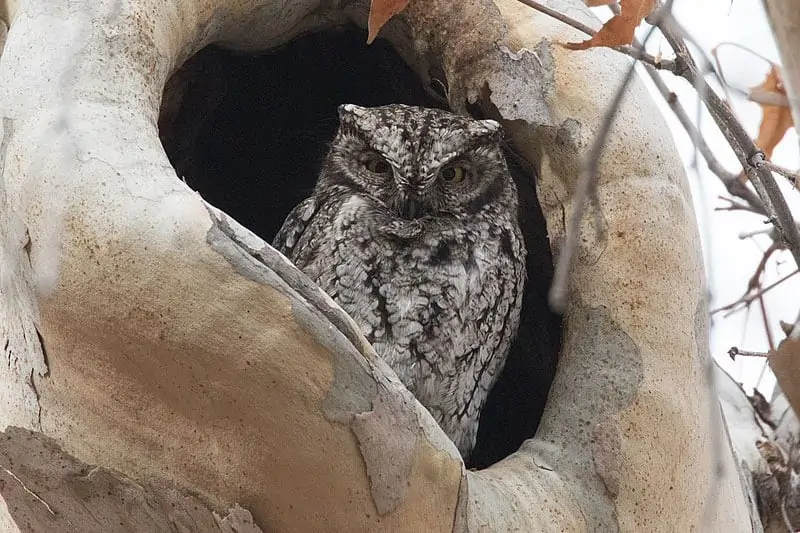
Length: 6.9 – 7.4 in
Weight: 3 – 3.5 oz
Wingspan: 15.7-19.7 in
Not just in Arizona, but throughout the United States, this species has a very small range. Only in the southern part of the state, bordering Mexico and New Mexico, can you find Whiskered Screech-owls. They’re a little smaller than the Western Screech-owl species above, but they look identical.
8. MEXICAN SPOTTED OWL
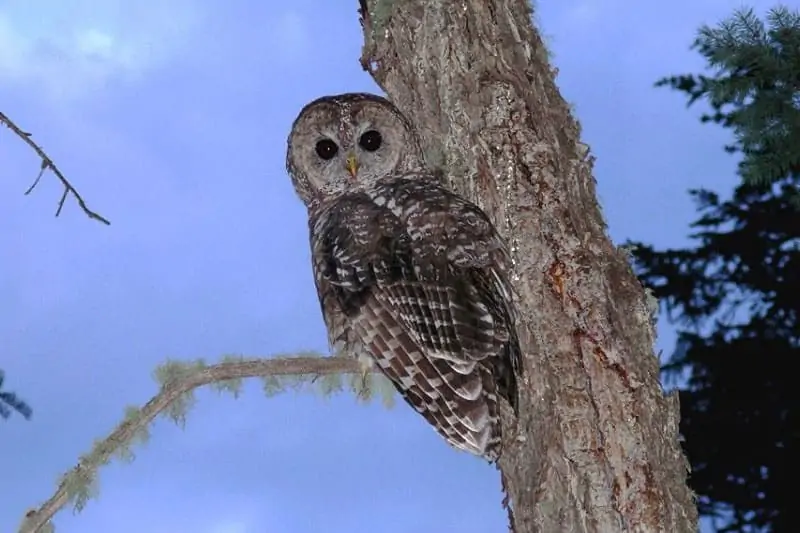
Length: 16-19 in
Weight: 19.5-23 oz
Wingspan:42-45 in
The spotted owl is one of three subspecies found in Mexico, and it is one of the biggest owls in North America. Both the United States and Canada have designated it as a species in danger. Mexican and foreign governments were also affected. They can be found in Arizona, Colorado, New Mexico, Texas, Utah, and Nevada in small pockets.
With a breeding population of just 15,000 owls, the Spotted Owl, including this subspecies, is declining due to habitat destruction. The United States is home to more than half of them. About 40% of the population lives in Mexico. The Barred Owl, which is bigger, more hostile, and known to push them away, is another element that contributes to their dwindling population.
9. NORTHERN PYGMY OWL
Length: 6.3-7.1 in
Weight: 2.1-2.5 oz
Wingspan: 14.5 -16 in
The Northern Pygmy Owl, a tiny owl that specializes on songbirds, is most commonly found in northern and eastern Arizona. Because the Northern Pygmy Owl is a diurnal bird, you have a better chance of seeing one if you are up during the day. Throughout the day, they remain motionless and quiet, hoping to catch their prey off guard for a meal.
Northern Pygmy Owls are unusual among owls in that they do not prefer artificial nest boxes. They are only about the size of an American robin, yet they have been known to capture prey up to three times their size. Their tiny stature, yellow beaks, and white speckles on their heads help to identify them.
10. FERRUGINOUS PYGMY OWL
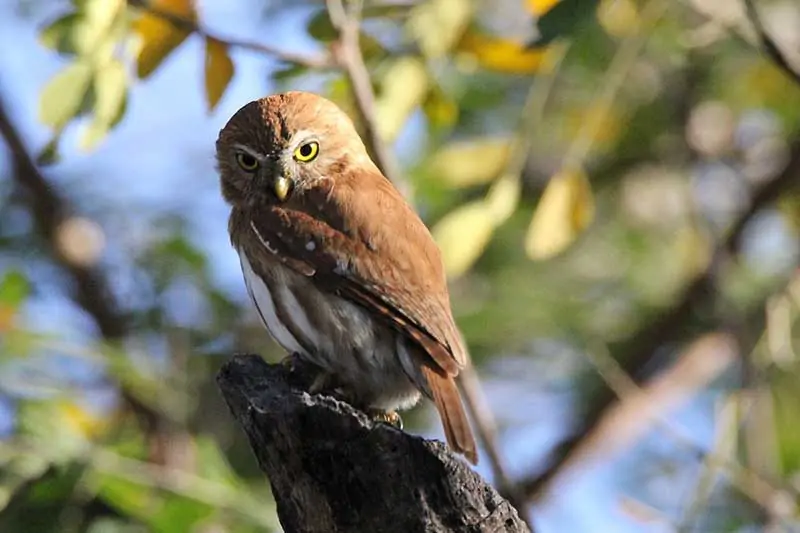
Length: 6.5 -7 in
Weight: 2.2 – 2.7 oz
Wingspan:14.5-16 in
The Ferruginous Pygmy Owl is only found in the United States and in Central and South America, but it is endangered here. Because of this, they are regarded to be scarce in both states, but may be seen on occasion near rivers and on deserts dominated by saguaro cactus near mesquite forests.
During the day, this species is mostly active and feeds on songbirds, insects, small mammals, and lizards. In their small corner of southeast Arizona, they live permanently.
11. FLAMMULATED OWL

Length: 5.9-6.7 in
Weight: 1.5-2.2 oz
Wingspan:15.9-16.1
In Arizona, particularly in central Arizona between Flagstaff and Phoenix in the National Forests, the Flammulated Owl has a very spotty breeding population. They are one of the tiniest owls in Arizona and North America, with a body roughly the same size as that of the Northern Pygmy Owl.
Flying insects, which they capture at night, make up the majority of their food. They look like screech-owls with shorter ear-tufts and have reddish gray feathers that are well camouflaged. Surprisingly, they have one of the lowest pitched hoots of all owls, despite their tiny size.
12. BURROWING OWL

Length: 7.5-9.8 in
Weight: 5.3 oz
Wingspan: 21.6 in
The northern section of Arizona is solely inhabited by the Burrowing Owl, while the rest of the state hosts a year-round population. Burrowing Owls, which typically nest and roost in abandoned burrows left by groundhogs or prairie dogs, are the only raptors that do so. They have been known to dig their own burrows on occasion.
They have long legs and yellow eyes, and are sandy-colored. Throughout the day, they hunt on the ground and fiercely protect their dens from invaders. When Burrowing Owls are most active, seek them out in the early hours of the day or late at night, when prairie dogs and other ground-dwelling creatures may be found.
13. ELF OWL

Length: 4.9 – 5.6 in
Weight: 1.4 oz
Wingspan: 10.5 in
At about the size of a sparrow, Elf Owls are the tiniest owls in Arizona and throughout the globe. They have a breeding range across southern Arizona. As they travel south to warmer climates in Mexico during the winter, look for them in Arizona during the spring and summer months.
The tiny size, lack of ear-tufts, and brownish-gray feathers distinguish Elf Owls from other owls. Insects and arthropods are the major sources of nutrition for them, although they will occasionally consume small lizards and blind snakes. In California, elf owls are recognized as an endangered species, while in Arizona, they are recognized as a threatened species.
